(From a 2022 interview with Master Rosarian Debbie Arrington. Originally aired on May 20, 2022, Garden Basics podcast)
Farmer Fred
What is America's favorite flower? Well, of course, it's the rose. Something like 85% of all Americans say their favorite flower is the rose. How do you grow them? Well, we've talked about that on this show. You can go back and look for various episodes of the Garden Basics podcast where we talked about planting roses and pruning roses. We've even talked about fragrant roses. However, our next guest we've had on several times talking about roses, including the most edible roses. It's Debbie Arrington, Master Rosarian, the typist behind the Sacramento Digs gardening blog, a daily effort that has all sorts of good gardening tips including tips on roses. And Debbie, I am so into cutting roses now for display indoors. Is this what happens when you get old? You just descend into a cut flower garden mode. And that seems to be what I'm doing. And all of a sudden, I love going out to the yard every day, and picking off some rose branches and bringing them inside for display. And from my perspective, what I'm looking for in a rose as a cut flower is something that maintains its beauty for several days, if not longer. Something that, when I'm picking it, chances are I won't get stuck by a prickle. I mean little prickles are okay, but I don't want anything too thorny if you will, please. Maybe something that doesn't shed a lot while it's on display. Things like that. Everybody has their own criteria, as you might discover. And I imagine, Debbie Arrington, in the world of Master Rosarians, this might be a topic of great discussion, shall we say?
Debbie Arrington
Yes, it is. Because there are literally tens of thousands of different rose varieties that you could choose from, and everybody has their own opinion of what is “the best”. But the qualities that you describe is a rose that has a long stem, a presence in the room and in the vase, has few prickles, so you aren't getting thorns in your finger every time you admire it. Those are all qualities that people that grow roses professionally want in a rose. And those are also good things to have in your own garden roses. So we have several favorites that we can share with you today. I should add that I'm President of the Sacramento Rose Society, and we just had our 74th annual show. And it was our first show in three years due to COVID regulations. So we had a lot of pent up energy. And our roses seem to, as well, because we had well over 1000 blooms in the room.
Farmer Fred
Wow. And who won?
Debbie Arrington
Oh, the the top prize went to Marilyn Monroe, not mine this time. But one that was grown by Charlotte Owendyk. Marilyn is an outstanding show rose. She's one of the best exhibition roses ever introduced. But I don't necessarily recommend Marilyn for everybody's garden because she has some of the most vicious thorns you will ever see on a rose plant. It's only because she is so beautiful she ever made it to the market.
Farmer Fred
Okay, I'll cross that off my list.
Debbie Arrington
The roses that were sitting next to her up on the top shelf are both really good garden roses, as well as exhibition roses that fit all the qualities that you want in a cut flower with a lot less pain. And those are Ring of Fire, which is a hybrid tea that is a dark orange bordering on red. And it just sort of flows. And it's a really large, but the buds measure about two and a half up to three inches long. Then when the flower opens fully, you know, it's about five, six inches across is a big rose the color. It has a sort of inner burning orangey color beneath the red. So it just sort of glows in the vase, so very eye catching rows and excellent dark green foliage. So it just really sets it off nice. And it puts out very long stems easily 24-30 inches, this great big rose on the top. So they're very handsome. And the other one that was the Princess of our show was was the aptly named Hot Princess. And Hot Princess is a wonderful rose, both in the garden and in the vase, because it has beautiful form to it, a beautiful point that slowly opens, it has that sort of rolling pedals. That's a dark dark pink, and another one that has this almost fluorescent color to it. And so both of those make them very eye catching. And when you're competing against 1000 other roses, you have to have something that is going to draw the eye to it other than than the other flowers next to it, and it does it in the garden and also does it in the vase, both those roses. One of the reasons they're so outstanding for exhibition is because they put out good long stems. The key to growing long stems is when you cut a rose, is to cut a lot of stem with it. And that includes deadheading to the plant. Right now people have a lot of roses, they've gone through their first flush of bloom. And there's a lot of dead roses on the plant that have spent flowers. Most people will just snip them off with maybe one or two inches of stem underneath it. So they're leaving a lot of stem on the plant and just taking off a little bit of stem with the rows. Well, roses tend to grow to a certain height and a certain stem length. So if you had a long stem, you'll get a long stem on the next replacement rose coming off that cane. But if you cut a short stem, just like you're dead heading the top of the rose, then the rose thinks I don't need to put out any stem, I've got plenty of stem there. And we'll just put a little little rose on a little you know, side stem on top of that, that other stem. So instead of having a nice, long straight stem, you have this kind of funky, crooked, growth up at the top. And in the garden that looks fine. But if you're growing for a cut flower, cut long stems every time you cut the bush.
Farmer Fred
Where do you make that cut? I have heard it often said that the place to make a cut when taking a stem for a rose is to make that cut just above a bud that is putting out a five leaflet leaf as opposed to a three leaflet leaf.
Debbie Arrington
Yes, you always go down to five leaflet because the leaflet right there at the base of that leaflet, where it attaches to the stem, is the node. And that node is what is going to generate the next step. You want that down farther in the plant. And you also want it to be pointing outwards, away from the inside of the bush so that when that new growth comes, it will be growing out, and not in. That improves air circulation inside the bush. It also makes for straighter stems because it doesn't have to compete with other stems inside the bush.
Farmer Fred
One of my criteria also for going out to the yard and picking roses as a cut flower is I really like it when there's a bunch of roses all in one spot. I'm thinking of the Sally Holmes, there seems to be a gaggle of roses that are attached to what would be a long single stem and it fills out a vase very nicely.
Debbie Arrington
Yes it does. That's what's called a spray. That's a multiple buds on one stem. All roses will produce a spray, some more than others. Some roses are bred specifically to produce large flower heads like that, also called large spreads. And Sally Holmes is one of those. Sally Holmes is a white climber. The flowers are single and they look like apple blossoms. And actually roses are a distant cousin of apples. So Sally Holmes, you can really see the relationship between the two. And Sally Holmes is one of those roses that will literally cover a fence or a house if you let it. It grows very vigorously, very fast. But it does put out one stem for a full bouquet, with easily eight to 12 flowerheads on that one stem. Other roses that are bred that way are the floribundas. And floribundas are a class of roses that were introduced about 100 years ago from breeding and what their name literally means is abundant flowers. And they are roses that instead of just putting out one terminal bud on the end of a stem and that's the scientific approach to what you're describing: one bud, one stem. That's a terminal bud on that stem. Instead On a floribunda, and Sally Holmes, they put out a spray. And those are several buds that are collected at the end of that stem..
Farmer Fred
What is the difference between a floribunda and a polyanthus?
Debbie Arrington
They're very different. Polyanthus tend to be little, itty bitty tiny roses, but lots of them. Polly means, "lots of" anthus. They put out on one stem, Oh easily, tend to 20 blooms, but they're tiny. They they look like little Tom Thumb roses, which is a variety, or Thumbelina, or something, something that is like a little fairy rose. In fact, a whole range of them are named after different storybook characters. There's a whole series of Snow White dwarfs polyanthus, that are named for each of the dwarfs. I've got Grumpy growing in my yard. And, Grumpy is hot pink, by the way, but the flowers are less than an inch across. And they had many little petals too. They're they're just dainty, and adorable. But they they're really nice in how they fill out, okay, because the key to making a good bouquet is not all the flowers are the same size. Now, if you're doing a formal bouquet, like an exhibition, they want all 12 roses to be exactly the same. But if you're making a bouquet for your table, or, inside or as a gift, it's really nice to have a variety of size flowers in there when you put together an arrangement. The basic formula is thrill, fill and the spill. And the thrill is your focal points. And those are usually, if you're talking roses, you're talking big roses. The fill is things to go between those big flowers and polyanthus make an excellent filler flower and they're these little tiny flowers that echo the big rows, but they're small, and they are usually lighter colors there. There's some dark pink ones, and there's a few reds too. Wingding is an excellent red polyantha and it's fire engine red, but a lot of them are like baby pink or white. And so it's like a nice, soft frame for the other flowers. And then your spill is your foliage, and other things that framed your bouquet and spill over the edges of the vase to soften the edge of the vase. So ivy is a good fill, it could spill. Ferns, any sort of your curved foliage that would complement the roses. I have a lot of sword ferns. And so I usually use those to fill out my rose bouquets. But I also have some different ivies which look really nice. And Nandina, the heavenly bamboo, and that's good for fill as well as spill. Because they have the little white flowers on the Nandina right now. And those look almost like baby's breath in the vase and a lot easier to grow. But other foliage that is just pretty foliage, this green foliage that frames the flowers nicely. You're softening the hard edge of the vase and framing your flowers when you add your foliage quite often, florists will add a sprig of citrus leaf, orange or lemon, because that adds an extra scent to the bouquet and a popular trick to add more rows sent to a bouquet of roses is a stem of rose geranium. Because the Rose Geranium actually has a stronger scent than most roses.
Farmer Fred
Do you want that?
Debbie Arrington
Sometimes, yes. For roses don't have that much scent. Might have a lot of look but not in a lot of scent.
Farmer Fred
Well, I distracted you from talking about floribundas.
Debbie Arrington
Oh, there's a lot, and floribundas they're a class of roses that are almost full size, hybrid tea roses. Most floribundas are three to four inches across when fully opened. But they have this blooming habit where they will bloom in a spray instead of single roses. And they can put out single roses too, but they tend to put out these big flower heads. And my favorite and the favorite of most people here in Sacramento is Julia Child. It is a wonderful butter yellow floribunda and Julia herself picked out this rose to honor her and it is a color of freshly churned butter to a lovely yellow and it grows in these big soft romantic curvy heads. They're very rounded, they're very soft and very full. So it has this sort of Old English look to it. The most of the sprays oh they've usually got five or six on it, but it has very good foliage, a very clean foliage so it's a nice kind of like a dark apple green and the scent on it is a really interesting licorice scent. It's not what you would typically say as a rose scent, but it's a beautiful yellow rose. It's really nice in the landscape because it stays in bloom, all through our heat without losing that yellow color. And that's one thing that's really tough in Sacramento, is that a lot of roses get bleached out in summer, because it's just too hot and you really get better bloom if you have an East facing garden instead of it being south facing or in full blasting sun. That way your your color will last longer. Other floribundas I wanted to mention that just put out pectacular bouquets include Betty Boop. Betty Boop is just a fantastic rose. But it can take all sorts of different growing conditions. And my Betty Boop right now, oh, it probably has 300 roses on it. It's tall. People tend to think floribundas are small, because they're marketed that way. You can prune a floribunda harder than a hybrid tea and keep it smaller. So you can keep the bush in a smaller space like three to four feet, instead of, you know, four to five. My Betty is about six foot tall and six foot wide and just covered with blooms. Betty Boop. Looks like each of the blooms are kissed, with bright red lipstick. Oh, they call it semi double. It's about eight to 10 petals. So the petals are very open and look almost single with real pronounced statements in the middle. And it's cream colored, but with this bright red edge to it. So it's like somebody painted lipstick right on the edge of each bloom. It's a lovely rose. So you can just imagine these big heads of those flowers in a spray with you know, 10 or 12 of them clustered together. They're just lovely. And bees love that rose because it has such pronounced stamens and very open blooms. So it always has a lot of bee activity. And it's just a beautiful rose in the garden. And another one of my floribunda favorites, it doesn't so much put out the big spray as it puts out a lot of singles, but it is just an absolutely gorgeous rose. It's called Daybreaker. And Daybreaker is a kind of an apricot blush color with a gold center and has a little bit of striping in it. And so every bloom looks like a slice of the dawn. And every one is different, just like dawn's art. No two are exactly the same. And it has beautiful dark green foliage that is totally disease proof. It never has any rust or powdery mildew or Blackspot or anything on it. It is just bulletproof as far as as any diseases, and I have a no-spray garden, so if somebody is prone to something, I know it right away. It puts out really nice long stems that look fantastic in a vase. It easily has about, I'd say, 60 blooms on that bush right now. And each of them has a two foot stem and that again is Daybreaker. Daybreaker. Yeah, it's a beautiful, beautiful floribunda.
THE BEST ROSES FOR CUT FLOWERS, Part 2
Farmer Fred
You used a couple of terms that probably need a bit of definition for people who don't know. You talked about roses that are singles and roses that are doubles, what is the difference?
Debbie Arrington
A single rose has fewer than eight petals. And quite often a single rose will have five or six petals. And it looks very open like an apple blossom with real pronounced stamens in the middle. And stamens are those little yellow gold things in the middle of the flower. It has a very open look to it like sort of like a daisy or something. You know, it doesn't even look like a rose a lot of times, which is one of the reasons they're very eye catching is because you have to think twice about what it is there. Betty Boop has a few more petals than eight. You know she has some roses on her that are probably about six to eight, but quite often has eight to 10. So that makes it called a semi double, which is up to 16. But other than that, roses are full roses, it just depends on how full. And so a full rose is anything above that. Most hybrid teas are in the 30 to 40 range, but your Austin roses, which are your big English red roses, that are supposed to be like giant cabbage roses, they can be 80 to 100 petals and that's why they get so full looking. They have so many so many petals. But that also makes them extremely fragile. And they quite often will burst and literally throw petals all over the room. It's pretty wild.
Farmer Fred
Yeah, I think that's another important criteria, is you don't want a plant on your dining room table that's going to make a mess.
Debbie Arrington
One that explodes. Yeah, so you know I have just a few Austin's because they get pretty big. And both of the ones that I have are in the ground, at least are ones that have smaller habits, which means that they stay under four to five feet. Because the thing about the Austin roses that they discovered these were shrub roses that were originally bred in England, where it tends to be colder than here in Sacramento. They stay smaller, you know, in like four or five foot range. But when they come to Sacramento, they love the warmth. They think it is just fantastic here and they will get to be you know, six to eight feet real quick and just as wide. And they're very handsome if you have the room, but they take up a lot of room. So the two that I have, one that they released a long time ago named Tamora which is kind of apricot color. And the other one is this new one that was released a few years ago named Olivia. And yes, they do name most of the roses after people are for women's names. Olivia is an outstanding rose if you're going to get an Austin rose. Olivia would be the one to get because she has all the good qualities and none of the bad for an Austin rose. She's a light baby pink, and with very full cabbage style flowers and incredible scent. Just a wonderful scent. And she puts out big sprays where one stem is a whole bouquet. She also can grow in semi shade because I've got her in a spot where she gets quite a bit of shade during the summer. And she keeps blooming and she has very few thorns. The big difference between her and Tamora is that Tamora is covered with prickles. Just terrible, terrible thing. But Olivia is just the best of the Austins for cut flowers.
Farmer Fred
Well, since you brought it up, will either of those explode on the dining room table?
Debbie Arrington
Oh Tamora does. Tamora will do it in a day. Tamora does not last well off the bush at all. But Olivia, when she goes, she will explode all over the table. Yes. Because she has just so many petals. And they have to go somewhere.
Farmer Fred
But do you recommend them as a cut flower?
Debbie Arrington
Yeah, because the scent is so strong. Okay.
Farmer Fred
All right. And, of course, most people are familiar with hybrid tea roses, in my experience with hybrid teas is they don't really have a long stem. They don't look great, that great in a tall vase. Or am I just being lazy on this?
Debbie Arrington
It depends on how you were cutting those stems, and how you were training that plant to grow. Because most hybrid teas are bred to put out nice long stems. That's one of the things that they look for in that rose. And there are a lot that will put out very good stems, especially for your first flush of flowers, those ones that you get in April in May.
Farmer Fred
All right. Now I know we've mentioned a couple of hybrid teas already, Ring of Fire and Hot Princess, what are some other good hybrid tea roses for cutting?
Debbie Arrington
Well, I'll start with the reds, because that's what people usually associate with cut roses is red roses. And that seems to always be the request that people have is what are some good red roses that I can grow and cut and bring inside? And everybody's favorite in that category is Mr. Lincoln. That's an old oldie, but still a goodie. And one of the reasons it's so beloved, is that it has a wonderful deep red rose scent, it's a very heavy scented rose, and that you bring one of those stems inside and it will fill a room with scent. So it's much sought after for that. It's a very dark red rose. And it's one of those roses that if it's planted in full sun, it can get kind of toasted. But it's a nice rose, you know, and it has wonderful long stems, and very consistent. Another good red is Olympiad, and Olympiad was introduced in 1984. For the LA Olympics. It's a classic red rose with a wonderful, high pointed center. It looks like a florist rose, has very few prickles on it. And a nice long straight stems. It has a beautiful red color that does not fade. So a very consistent rose in the garden. And a red rose that was introduced recently that is a outstanding red rose that looks just like a florist rose, is called Veteran's Honor. And it is a dark red with a high point and it lasts a long, long time in the vase, it will last easily a week, and it will still be continuing to open during that time, instead of opening really quickly. That's the one thing about Mr. Lincoln, is that once it's off the plant and in a vase it will tend to open fairly quickly. While Olympiad and Veteran's Honor will stay in their bud form much longer.
Farmer Fred
Is that a good thing? That's another thing I've been wondering about as I'm pursuing this new hobby of cutting roses for displaying indoors, is I see some of these with full open flowers. And yet there were buds that haven't opened right next to it. And I'm wondering, well, maybe I better not cut it because those buds will never open,
Debbie Arrington
The buds will eventually open. In most cases, the key is to keep getting water up the stem. And so when you bring that flower into the house, really cut the stem underwater, because it will remove any air bubbles. And it will get better flow of water up the stem. And recut the stems every couple of days. Also underwater again, to keep that flow of moisture coming up the stem. Because as long as there's there's water coming up the stem, those buds should continue to develop and open.
Farmer Fred
Now explain to me exactly how to do that. Do you keep a bucket in the kitchen and then take the rose out of the vase, put it in the bucket, make the cut and then quickly transfer it back to the vase?
Debbie Arrington
Yeah, but I don't even take a bucket. It's just like a cup of water or something. It's just just long enough for me to get a pair of scissors in there to snip the end of the rose because it doesn't need much, just about an inch from the bottom of the stem.
Farmer Fred
Okay, that's a good tip for cutting roses: trim them every couple of days and do it underwater and then plunge them back into, I imagine, into fresh water in the vase.
Debbie Arrington
And you can use some sort of flower food. That will help keep the water cleaner. What it does is add some sugar to the water and that is some nutrients. It's like giving your plant fertilizer and help the plant continue to be robust off the plant.
Farmer Fred
Will ginger ale accomplish the same thing?
Debbie Arrington
Yeah, So does sevenup or sprite. As long as you don't use diet versions.
Farmer Fred
Okay, well good. Now I know what to use that unopened bottle of ginger ale for.
Debbie Arrington
it will work. It's like ginger ale does have have some ginger in it. So It will color the water, but sprite and seven up, you know, they don't have any coloring in it so it doesn't come into the water as long as you don't use diet. Another tip while we're talking about it, is make sure to remove all the foliage that's going to be below the waterline, because the foliage will decay when it's underwater. And that will ruin the water. It makes it all funky.
Farmer Fred 30:24
So do you use tap water to put your flowers in? Or are you somehow maybe using a filter?
Debbie Arrington
I just use tap water, that's fine. Our water's fine here. I mean, there's a problem over in the Davis area because of the boron in the water. But most people have that filtered off their tap, anyway.
Farmer Fred
What about soft water systems?
Debbie Arrington
Oh, geez, it should be fine. Okay,
Farmer Fred
I guess the other option is to use like a Brita filter like you'd use for drinking water and use that.
Debbie Arrington
Yeah.
Farmer Fred
Let's go back to hybrid tea roses and add some color to our to our red selection of Mr. Lincoln, Olympiad and Veterans Honor. What are some other colorful hybrid tea varieties for cut roses?
Debbie Arrington
Well, a lot of people love pinks and there are a lot of great pinks. One right now that a lot of people have and it's a very popular rose for several reasons is Pink Promise. And Pink Promise was distributed a few years ago as the breast cancer rose. A portion of sales went to a Breast Cancer Research Fund. And it is a lovely, classic shaped, really light pink rose. Very much like a baby pink, with just a little bit of a darker edge around the petals. And what's outstanding about this rose though, it puts out really long stems, beautiful, two to three foot long stems with these huge roses that are easily three inches long. So they're beautiful, but the one thing it does tend to fade out in heat and so it gets a little toasty around the edges, but it's a very pretty rose and very nice long stems and not many thorns on it either. So it's very good that way. A traditional pink, there's two that have a very kind of a fluffy look to them, but are really nice pink and one of them is Queen Elizabeth. Queen Elizabeth is the original grandiflora rose. Grandiflora is a cross between a hybrid tea and a floribunda. So it has that habit of putting out big sprays on one stem but they're full size roses and very showy and very big. And Queen Elizabeth was introduced the year that Queen Elizabeth the second took the throne, back in the early 50s. And it is an outstanding medium pink rose that just blooms and blooms and blooms. And she looks fantastic in the in the landscape and she's fantastic in the vase. They tend to open up quickly as a lot of grandifloras do tend to open up quicker than hybrid teas. A stem is a bouquet so it's a really, really nice rose. Another good pink that looks similar to Queen Elizabeth but is a hybrid tea is named Friendship. And that's a lovely rose. And those roses, they'll last a week off the bush easily. And another pink, this rose is wild, it is Gentle Giant. Gentle Giant is hot pink with a little bit of yellow in the throat and those blooms are easily eight to 10 inches across. When fully open, wow they they are immense. They're really impressive. And very very pretty. it's a lovely color in the blend. And one that has a wonderful scent and that lots of people love is Double Delight . Double Delight doesn't have that long of stems. it tends to stay a shorter plant but the flowers are just beautiful. And they have this wonderful kind of apple scent to them. They're cream colored with red coloring on the edges of the petals and the more heat and sun it gets the redder the bloom when early in the season. It will look very cream colored with just a little bit of blush on it. But by the middle of summer, it will look like it's a red rose with a little bit of white in the throat but it has a wonderful scent and it's another one that can really fill a room up with perfume and it looks good in the garden and good on the table.
Ones that are yellow. Yellow is another popular color. And there are some excellent yellows that have come out recently. One of them is called About Face. About Face is a grandflora and it's really tall. it's definitely one that you want to put at the back of the bed because it goes six feet and up and it can throw up canes that are 10 foot tall. They're just amazing, which means it always has great long stems if you're looking for long stem, and the roses are easily six inches across when fully open, and they're bi-color on the inside of the petals. It's a light gold, but on the outside of the petals, It's a copper color. It's a real dark copper. And so it looks like two different roses on the same plant as they open up. It's a really interesting rose, and very pretty. One that's more traditional gold is called Strike it Rich. It's a grandiflora., And another one is Gold Medal. It's also a Grandiflora and one of the things about the grandifloras is a lot of them have fewer prickles, which makes them a lot smoother stemmed. And so they're easier to work with. And they're definitely easier for a bouquet.
Farmer Fred
And that last one, of course, was Gold Medal. Please continue.
Debbie Arrington
Yes. And Gold Medal is one that is a beautiful exhibition rose as well as in the garden and in the vase. It's a gorgeous, perfect yellow form. And it keeps it's dark yellow, which is really nice. While Stike it Rich is more of a soft gold as you would think, because it has, you know, they're both golden in their names. Love and Peace is a combination of red and yellow, which is really striking in the vase. It was a hybrid created between the Peace rose, which is a beautiful light yellow pink combo, and a rose named Love, which is a beautiful red rose. And in one of those weird happenstances it actually worked where they got what they were aiming for. It looks like a Peace rose with a dark red blush. And it's a very striking rose in the garden and in the vase. Perfect Moment is another one that's a red and yellow blend that's very striking as a cut flower. It has very nice long stems, and very consistent. My bush puts out 36 stems at once. With these big, big buds on them. It's a very, very good looking plant. Sunset Celebration is a wonderful orange. It's kind of a medium orange, somewhere past peach. It's a really nice orange color that holds this color instead of fading into something that's attractive. And it opens very slowly and has long, nice straight stems. It's a very good looking rose, and I have one left, that's a purple rose, because purples are good. Silver Star is kind of a lavender-mauve color. And it tends to put out a lot of sprays. So it's another one that has this bud habit of a bouquet on the stem, and it will bloom in summer shade. I've gotten in a spot where it's getting less than five hours of sun a day, and it blooms beautifully.
Farmer Fred
I will repeat that for those of you who like me may be blessed with more shade than you'd like, the name is Silver Star. Now let's talk a little bit about some, shall we say, rose confusion that exists out there because if somebody goes shopping for roses based on what we're chattering about here, and let's say they see Love and Peace. Well, they may see the hybrid tea like we've been talking about, but they may also see a miniature Love and Peace and a lot of these roses come in more than one form, don't they?
Debbie Arrington
Well, it depends. There's only a few of them really, where they doubled up on the name, because the registry tries to stop that confusion. But there are many forms of roses and miniatures are our one class of roses and miniatures are not referring to the size of the plant, they are referring to the size of the bloom. And miniature rose blooms tend to be under two and a half inches. There's smaller blooms. And the plants also tend to be smaller, generally will stay under three feet tall. And there's some that only grow to about ankle height. And in a container they'll stay quite small and compact. The roses can look like hybrid teas they can look like floribundas with big sprays, but they always are smaller. And so that that's why they're called a miniature.
Farmer Fred
Well, I have plenty of small vases. So I bet there's some good miniatures that make for good cut flowers.
Debbie Arrington
Yeah and closely related to miniatures are a class they created a few years ago called minifloras, and minifloras are that gap between miniature and floribunda. So it gets even more confusing. But yes, there are many miniatures that look really nice in a vase. Everybody's favorite in Sacramento is this one called Joy. and Joy is a classic, old creamy white rose, but has this purple peak edge, a picotee edge on the blooms. And they look like little hybrid tea roses. They they have that perfect form of a hybrid tea with a pointed center. But it has this edge that's this purple pink. That's very pretty. And it puts out lovely sprays. It's a really nice looking rose on the plant and also in the vase. It's just gorgeous. It almost always wins when when somebody brings in a good Joy.
Farmer Fred
Yeah, that is the rose that got me interested in doing roses as cut flowers, because the Joy in my yard last year just performed outstanding. It was in a very warm area too. And yet it bloomed and bloomed and got like four feet tall.
Debbie Arrington
Yeah, it's a very vigorous plant. It's really lovely. There's another that it's been an instant hit. And its name is You’re the One. And it is pink and yellow blend. And it's a very vigorous plant. And it's just covered with flowers right now, mine is at least, and they look like like full size hybrid teas, only they're tiny, maybe about two inches across. But very pretty. Kind of hot pink with it with a yellow blend at the throat. And my favorite miniature, at least in my own yard, is one that's called Rainbow Sunblaze. And it is a red yellow blend, it has more of a ball shape in the middle instead of a pointy center. But it just blooms and blooms and blooms. And so it's one of those I can always make a bouquet off the bush, you know, and it stays fairly compact. It's about two and a half feet tall. But easily that wide also, and just covered with buds. So it looks spectacular in the garden. And it also allows me to make lots of bouquets after that.
Farmer Fred
So I'm going to make an assumption here. I hope it's true. There is in the world of roses, a lot of single blooming roses where you get one major flush per year. And I think all the roses we're talking about today are repeat bloomers.
Debbie Arrington
Yes, it is. And there's a lot of older roses that only bloom in spring that are just single bloom roses. And a lot of your species roses and old garden roses will only bloom in spring, they bloom just once a year. But everything we've been talking about today, blooms multiple times a year, and very reliably. The thing about roses is that they react very predictably, when you cut off a stem, they will try to grow a new stem with a new flower on it. And that will take about six to eight weeks, depending on weather conditions until it blooms again. So if you have a major event coming up and you have a lot of flowers in your garden, you want to have a lot of roses for people to see. Like you know you're having a party or a wedding, backyard wedding or something like that. Count back eight weeks from the event and prune your rose bushes. Because the roses will put out new blooms that will bloom in six, eight weeks. And so it will have a very predictable flower show when the time comes. So you can use that. It also works if you're planning to have a rose show.
Farmer Fred
Or a wedding. Wedding events. Yeah. So people who plan weddings well in advance. You want to, if you're going to have a summertime, especially a late summer wedding in your backyard, then six to eight weeks beforehand, prune the roses. Do you have any more tips for growing roses or caring for roses as cut flowers? How often do you fertilize them, for example?
Debbie Arrington
Right now about once a month. Well, because I started my pruning schedule in anticipation of having an April rose show. I had a big bloom in late April. And so now my plants are cycling back. It's at that time of year where they're warming up again. So I've been doing a lot of deadheading. And so now that they're deadheaded they need some food. So I tend to fertilize after I've done a lot that.
Farmer Fred
Any of the roses we've mentioned, will most of these roses work well across the portions of the country that grow roses, I guess would basically be USDA zone six through nine.
Debbie Arrington
Oh, yes, definitely. Roses, you know, admittedly they grow better in Sacramento probably than just about anywhere because we have just about the perfect growing conditions for them.
Farmer Fred
We have low humidity, there's no summer rain and there's no Japanese beetles.
Debbie Arrington
Yeah. So we have good soil, we have everything they need. And roses actually are very drought tolerant. You know, that's one thing to remember. You know with them is, is they can get by with less water if you need to. The one thing is when you do cut back on your water cut back on your fertilizer. You can burn your plants.
Farmer Fred
And I imagine mulching would play a big role in making them more drought tolerant, too.
Debbie Arrington
They appreciate mulch.
Farmer Fred
Alright, did we leave anything out?
Debbie Arrington
To prompt more bloom, you need to cut your roses regularly. You need to cut out the spent blooms and encourage that plant to bloom more. Some people, though wonder why the roses aren't blooming, and then they realized they never took off the old roses. And if you don't take those off, that rose will think that it is done for the season and it should just let that turn to fruit.
Farmer Fred
Which is higher in vitamin C than most foods.
Debbie Arrington
Yes, rose hips are very high in vitamin C. That's for a podcast for the fall.
Farmer Fred
There you go. Cutting roses. Add them to your garden. A good pair of snippers to helps as well. Debbie Arrington, thanks so much for all your help, growing some good roses today.
Debbie Arrington
Thank you very much. It's my pleasure.
(Here’s an update from Debbie, with the 2023 Sacramento Rose Show results:)
“Yes, we did hold our 75th Sacramento Rose Show on April 29 at Shepard Garden and Arts Center. Two weeks before the show, we were worried if we were going to have any entries. It had been so cold and wet, nobody seemed to have any blooms. (Baldo Villegas had only one or two open buds at that time -- out of 3,000+ bushes.) But then it turned 90 degrees and bam! Roses everywhere. It just shows roses like heat and sun. And when they get it, they grow and bloom rapidly.
Our top roses were all oldies. I'm inclined to think that these all came from well established older bushes that really benefited from the rain. (I know it's true in my case.)
Winner of the 75th Sacramento Rose Show Queen of Show was 'Mikado,' a 1987 red-gold blend hybrid tea. It's similar to Perfect Moment but bigger and redder. The inner petals just glow. Beautiful straight stems. Classic form with a lot of petals (35).
And it was my rose. It's only the second time I've won Queen HT (Hybrid Tea) at Sacramento. (I've won Queens of minis and minifloras.) The other time I won was with 'Marilyn Monroe' in 2017 (maybe 2018). Marilyn wins a lot. That rose was introduced in 2001.
Mikado is now out of patent, so it may become more widely available as a non-patent rose. It was an AARS winner.
King of Show was 'Veterans' Honor," a beautiful red HT, probably the best red long-stem rose available. Introduced 1999.
Princess of Show went to a real oldie, 'Paradise," a 1979 AARS winner. (I had one of these at the Long Beach house.) It's mauve with outer petals of red-purple, and has a great scent. It is available as a non-patent rose. Linda Larsen, an up-and-comer in our club, exhibited both the King and Princess.
Another of my HT roses made the Court of Honor: California Dreamin'. It's a 2009 introduction and just delightful -- big, creamy white blooms edged in purple pink. The hotter it gets, the more pink on the petals.
For really long stems and some unusual roses, I recommend 'About Face.' It's a 2003 AARS-winning grandiflora. It puts out 8-foot stems all the time -- crazy long stems. (They're not canes because they're not sprouting from the graft.) The cuplike flowers are copper on the outside of the petals and golden apricot on the inside. Very impressive, but it needs room.”
Thank you for also listening to the Garden Basics with Farmer Fred podcast! It’s available wherever you get your podcasts. Please share it with your garden friends.
Fred Hoffman is also a University of California Cooperative Extension Master Gardener in Sacramento County. And he likes to ride his bike.




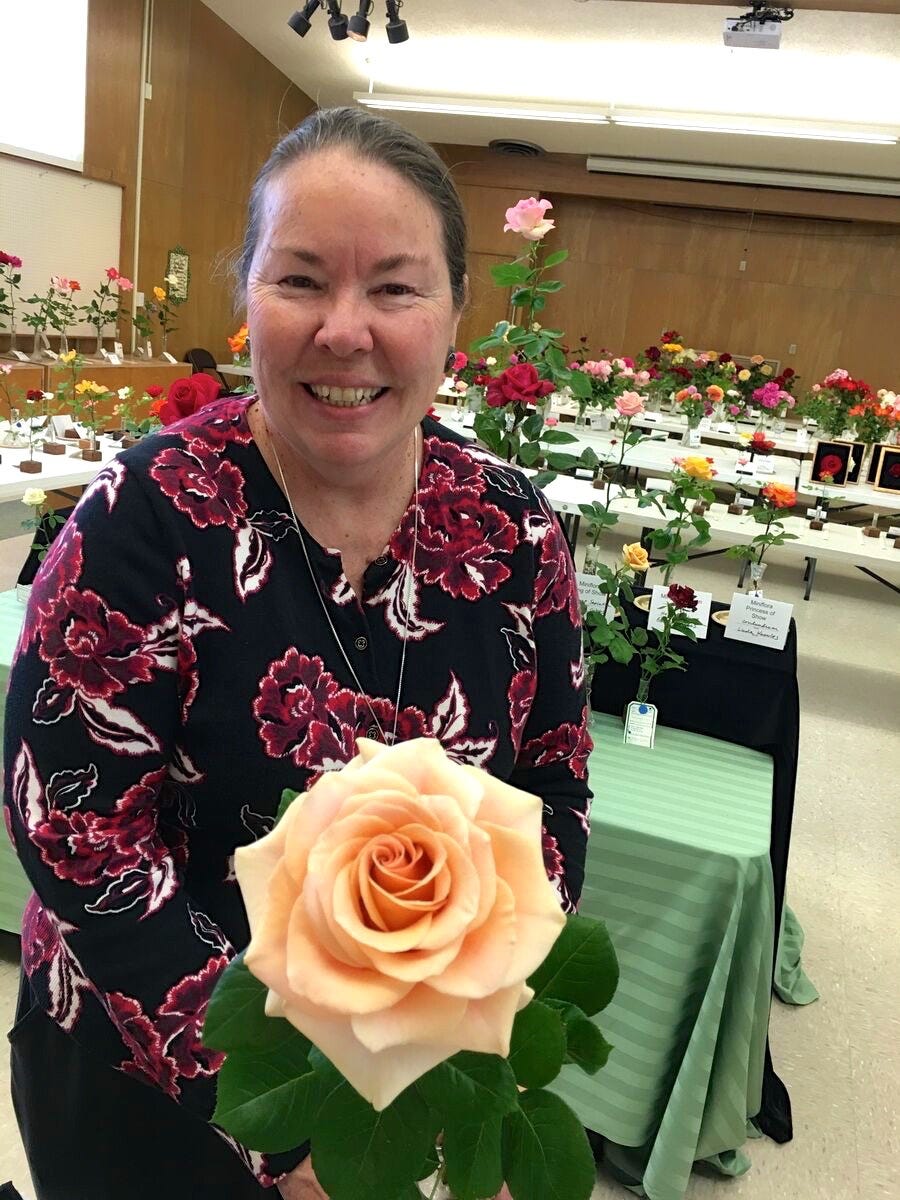
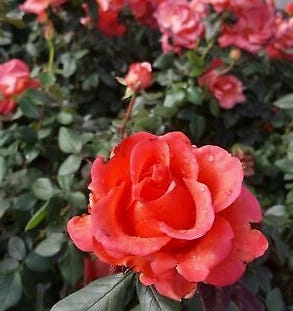
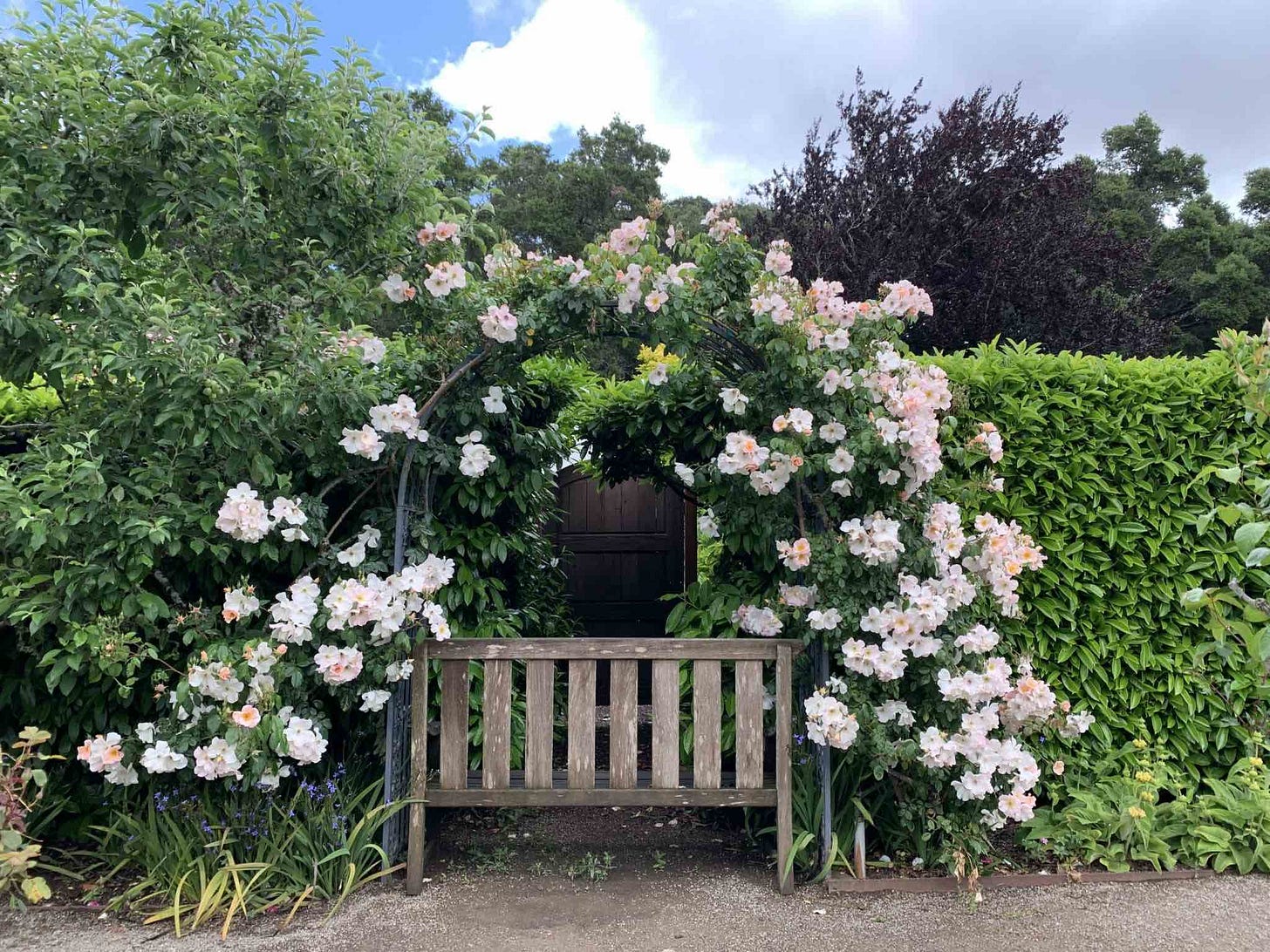
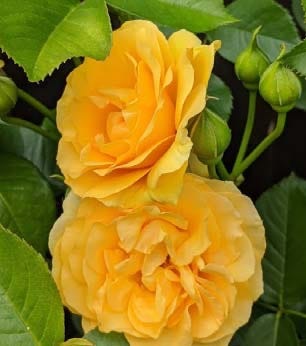


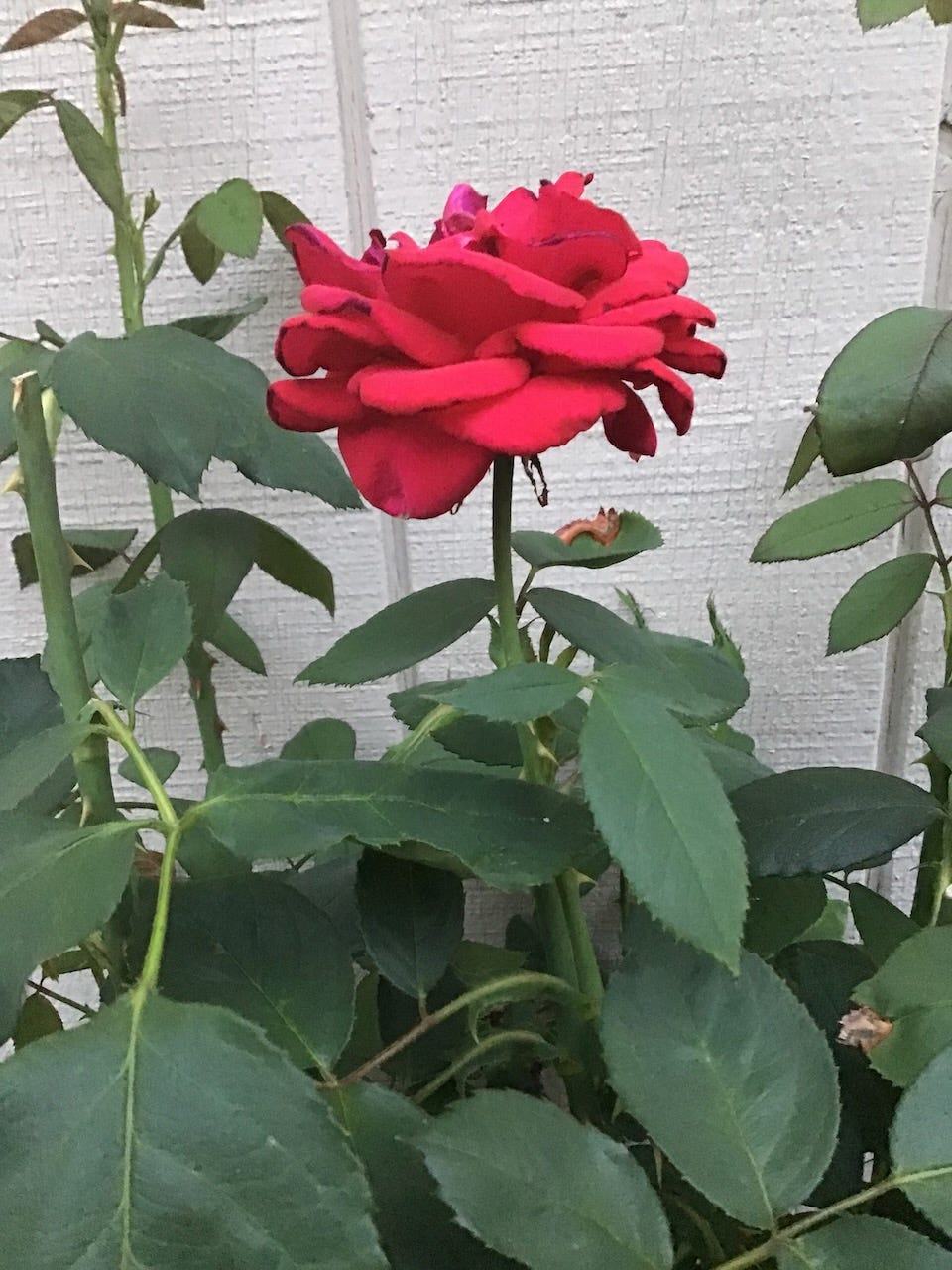

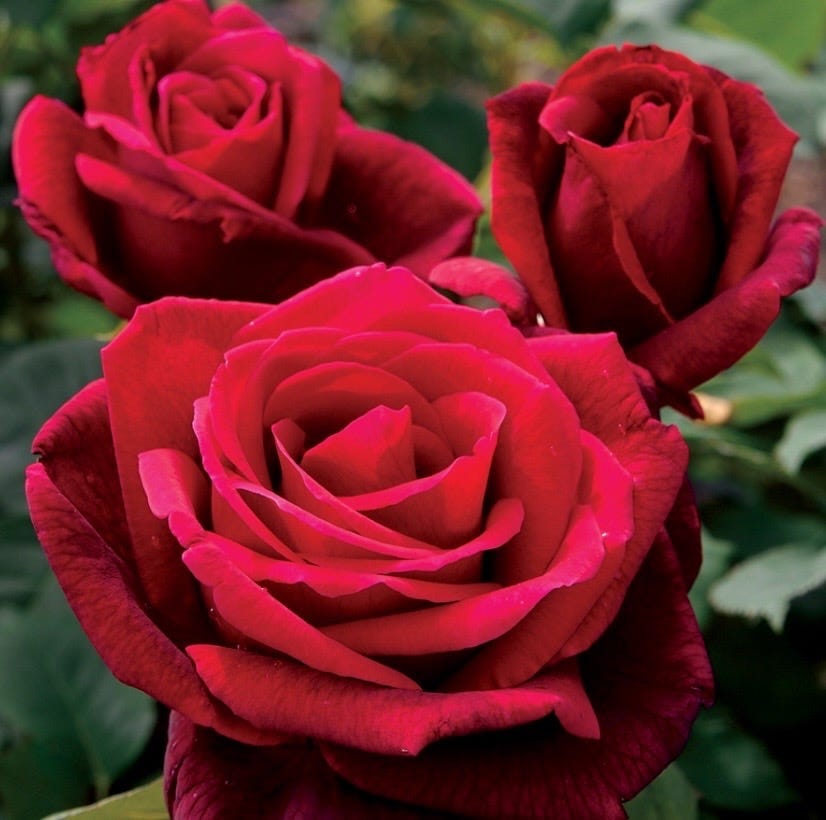
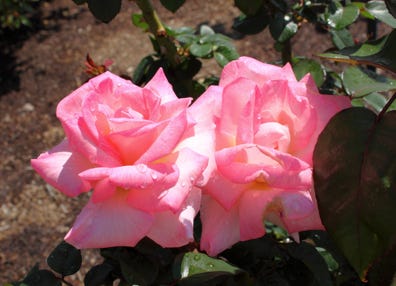

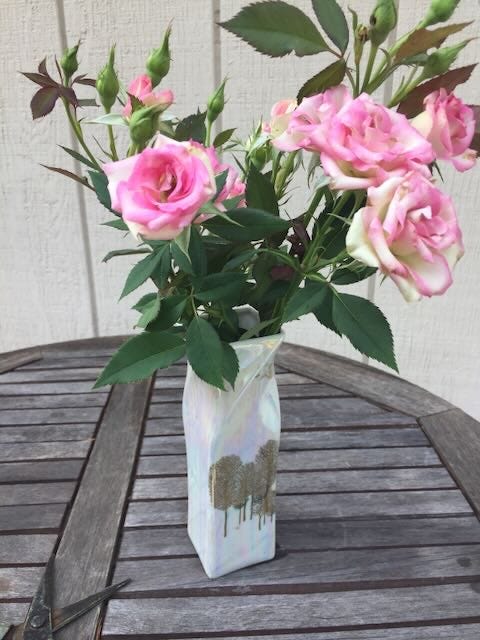

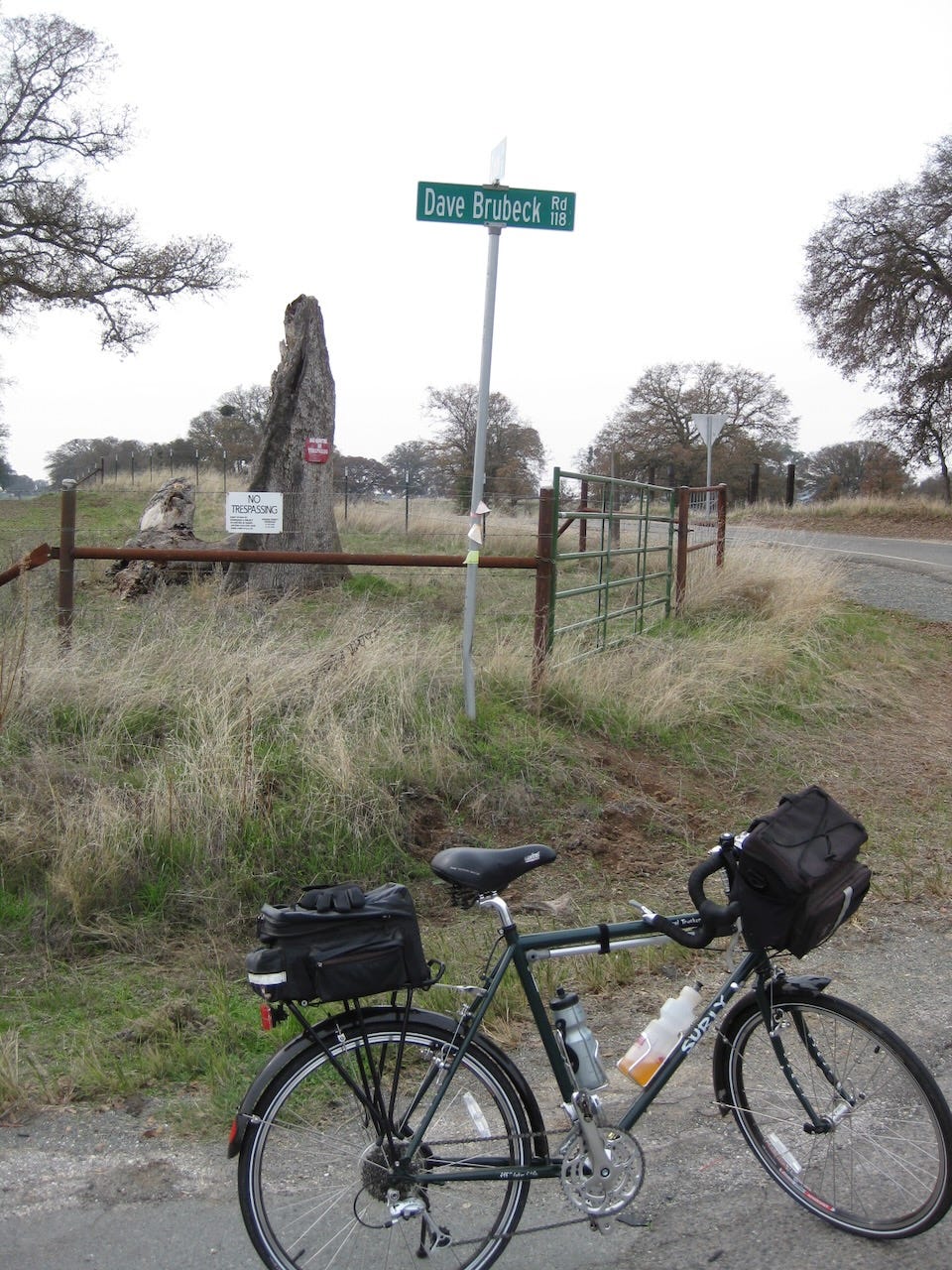


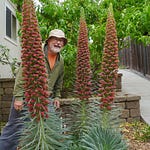

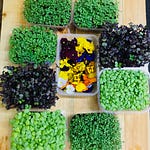



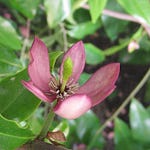
Share this post